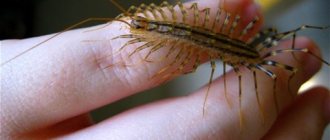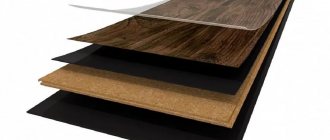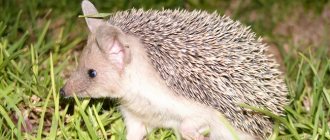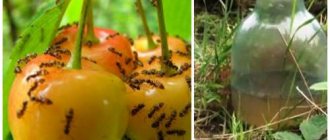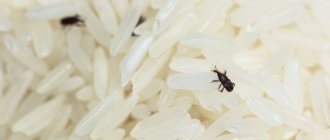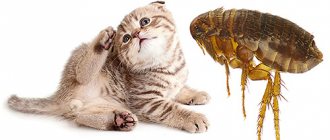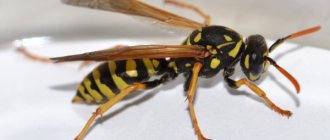With the arrival of spring and summer, entire colonies of bright red-black beetles appear in summer cottages, household plots, as well as in forest parks and gardens, which are called the soldier beetle for its attractive and original coloring. These insects reproduce quite quickly and if they are found on the site, something needs to be done about them.
Insects are not large in size, but their large number can affect the quantity and quality of the harvest. The soldier beetle does not pose a danger to humans, so you can limit yourself to preventive measures, without the use of toxic substances.
External differences of the soldier bug
The body of the soldier bug is round and slightly flattened. The insect has a bright color: the body is black, there is a red pattern on the pronotum and elytra. Bedbugs don't have wings. The eyes are red, the mustache and legs are black. The length of the soldiers is 8-11 mm. The oral apparatus is equipped with a perforating-sucking proboscis, which is located in a horizontal position.
When eating food, the proboscis tenses and becomes like a needle. With its help, the insect pierces plants and feeds on cell sap.
Red bugs often gather in groups in one place - adults and larvae, which is a distinctive feature of the species. The name “soldiers” comes from the ability to gather in a kind of division and from the color of the chitinous cover.
Who is often confused with?
The red bug is often confused with two insects:
- Firefighter beetle, soft beetle (Cantharidae). In fact, there is nothing in common between insects, except for confusion in names. The fire beetle belongs to the order of beetles. Its body length is 1-1.5 cm - twice that of the soldier insect. The elytra and tarsiers are black with stiff whiskers. Gnawing mouthparts. Insects have wings that move through the air. The beetle's belly is orange or red.
- Blackhead (Corizus hyoscyami). In appearance, insects are very similar to each other. The differences lie in the position of the head: triangular, slightly inclined and shaped like a pattern on the back. The eyes are darker than those of the soldier insect, closer to brown. Insects live mainly on umbrella plants: onions, dill. The larvae feed on henbane and tobacco leaves.
In England, the soft beetle is called the soldier beetle due to the similarity of its color to the uniform of the royal guards.
Distinctive characteristics
The soldier bug is not the only name for this bug. Due to its unusual coloring (patterns, spots with black dots on a red background), it is also called a fireman. And the absence of hind wings explains the third name - wingless red bug.
The soldier bug looks like an ordinary ground bug with a characteristic pattern on its back.
Please note: the wings are yellow, but the pattern is always the same.
The size of the bug does not exceed 8-10 mm, and the body has a round, slightly flattened shape. Instead of a mouth, the soldier has a kind of proboscis.
However, only a description of the appearance cannot give a complete description of this bug. It’s not for nothing that they call it a harbinger of spring, because bedbugs with a red back and black stripes are among the first to emerge from their shelters after the winter cold.
Insects carry out their life activities in groups.
Small colonies of firebugs are found in various places:
- near fallen trees.
- Along the fences.
- In woodpiles with firewood.
- Etc.
Striped bugs always cluster on an open surface as close to sunlight as possible.
Bedbugs prepare thoroughly for hibernation, which lasts all winter, by selecting dry cracks in fences, old houses, and tree trunks in advance.
The soldier bug is visually very similar to the firefighter beetle.
Insects can be distinguished by the following characteristics:
- body shape (in a beetle it is more elongated).
- A specific aroma characteristic of bedbugs.
- The ability to fly, which the fire beetle boasts.
The latter protects the plantings from pests, which include the wingless red bug. This type of bed bug appears extremely rarely in an apartment.
Life cycle
The lifespan of a wingless insect is 12-14 months. In warm regions, two generations of insects appear, in cold regions - one. By the end of August, the soldiers' metabolism slows down, that is, they are preparing for hibernation - suspended animation. After going to sleep, insects survive thanks to nutrients accumulated over the summer and a slow metabolism. Bugs wake up in March - April, as soon as the sun begins to warm the earth and the first vegetation appears. Some young individuals and females cannot withstand the spring cold and die. Adult females lay eggs in May. The process of insect formation occurs in several stages: egg - larva - insect... Newly formed females continue reproduction in mid-late June.
What does it eat?
Soldier insects feed on seeds, plant and fruit juices, as well as the remains of other insects. They bring food closer to the ground; they will climb a tall tree only as a last resort. In the absence of sufficient nutrition, bedbugs feed on weeds and even their own relatives. Red insects have a powerful proboscis that can pierce fairly hard shoots and plant seeds. Insects cannot harm humans. The proboscis cannot pierce the skin of an adult or child. Small larvae feed only on the sap of young shoots. The mouthparts are not fully developed, and insects cannot pierce other plants.
Soldier bugs, like all representatives of the species, have scent glands. In adult insects they are located on the chest, in larvae, on the abdomen closer to the dorsal part.
Habitat
This species has a very wide habitat. It can be found throughout the territory, from the Arctic Circle to tropical forests. It inhabits all of temperate Eurasia and northern Africa, and it has also been introduced to North America. In Russia it is present throughout the territory.
What does it eat?
Red bugs and their larvae consume cell sap, using their proboscis to pierce the hard shell of the leaf and gain access to the nutritious sap, without disdaining any plant growing in the garden. It also comes with the seeds and fruits of some trees and shrubs. In rare cases, the wingless red bug can feast on the corpses of small invertebrates and even resort to cannibalism.
Where is it distributed?
The soldier bug is widespread in Eurasia, northern Africa and the USA. Countries with temperate climates favor the breeding of insects. Bedbug habitat:
- under the bark of trees;
- on the stumps;
- in piles of dry grass and leaves;
- at the foundations of houses, resorts, gazebos and other outbuildings;
- in the fence and its foundation.
During hibernation, insects are found under heaps of garbage, in humus, on trees - under the bark or in hollows.
Wintering - those who survived
For wintering, bedbugs choose a warm and dry place, for example, under your baseboard or on suspended ceilings. The places where pests hide are most often various kinds of crevices in wooden buildings or parts of exfoliated bark. Therefore, do not be lazy and treat the first of them with an insecticide, and scrape the second with a wooden scraper and burn.
With the arrival of spring, when the soldiers run out in neat rows to bask in the sun, then they can be destroyed!
Sources
- https://fishki.net/3785717-klop-soldatik-i-interesnye-fakty-o-nyom.html
- https://TaraKlop.ru/klopy/klop-soldatik-kak-izbavitsya/
- https://lifeinsect.ru/klop-soldatik.html
- https://prusakam.net/zhuk-soldatik/
- https://misterklop.ru/vrediteli-ogoroda/klop-soldatik-foto-zhuka-opisanie-sposoby-izbavleniya
- https://rusfermer.net/ogorod/vrediteli/klopi/soldatik.html
- https://www.botanichka.ru/article/vrednyi-li-klopyi-soldatiki-i-kak-ot-nih-izbavitsya/
- https://KlopVred.ru/klopy/klop-soldatik/
- https://masterklop.ru/klop-soldatik-i-metody-borby-s-nim/
- https://klopec.ru/klopy/klop-soldatik-kak-vyglyadit-prinosit-vred-ili-polzu-krasnyy-kusaetsya-kak-izbavitsya
How does it reproduce
Insects reproduce quickly in spring and summer. In warm regions, bed bugs produce two generations from May to July. The colony quickly increases in size and, living on the site, quickly “attacks” cultivated plants. During mating, the male and female are attached to each other with the back of their body. Insects can remain in this position from one to two hours to several days. After the seed cells enter the female’s body, the insects separate. The female lays her eggs in the natural habitat, on the leaves of plants or in a place that makes it easier for the larvae to feed. A clutch may contain 16-30 white eggs, similar to rice eggs. On the top of the eggs, peculiar caps are formed, through which the larvae emerge after seven to ten days. Young individuals can remain motionless for a long time, feeding on the sap of the plants on which they are found. In appearance, they differ from adult insects not only in their small size. The larvae are completely red, without black inclusions.
Interesting facts about red bugs
Few people know about the features of toy soldiers:
- Cannibalism is common among insects of this species, which is due to a lack of useful substances in the pest’s body in winter, when hunger becomes quite noticeable, stronger individuals begin to attack those that are weaker;
- the transformation cycle of insects is incomplete, which means that the larvae skip the stage of pupal formation, and larvae emerge from the eggs, which continue to develop until they reach sexual maturity;
- after contact with a bug, a smell of moderate intensity remains, but if the pest is destroyed (crushed), it begins to smell much stronger;
- life expectancy varies from 6 to 12 months;
- thanks to their bright color, the toy soldiers are not attacked by birds, and their appearance is a warning to natural enemies that the toy soldier is a poisonous insect (dangerous only for insects, not for people);
- The bug does not bring significant benefits either in the garden or on the garden plot.
Reasons for appearance
The main reasons for the appearance of soldier bugs on the site include:
- rotten stumps in the garden;
- dried plants;
- piles of dry garbage and leaves;
- a large number of weeds, especially quinoa and wormwood;
- legumes;
- piles of wood;
- alfalfa in your or neighbors' garden;
- growing carrots, cabbage, beets, currants on the site.
Insects especially love alfalfa. To get rid of the larvae, you need to uproot the grass and burn it.
The insects often nest in legumes and alfalfa to combat winter cold.
In some cases, insects may appear in an apartment, more often in a private house. If you have indoor flowers, seedlings or other vegetation, insects will multiply very quickly. There is a tendency that when a soldier appears, other relatives run after him. If there is no food, they die or go to other places.
Unique creature
Firefighter beetles are predators; they eat insects that are smaller than them, as well as those that also have a soft body (the beetle cannot bite through the chitinous layer). Most often they like to eat aphids, caterpillars, larvae, leaf beetles, small chafers and sleepy flies.
The firebug's hunt begins in the air. He looks out for his prey even during the flight. Having found a suitable insect, the fireman lands in close proximity to it or even directly on it. Next comes the jaws. The winged predator bites through the victim, injects poison and digestive juice into it, after which its insides become soft and the beetle drinks them. Firefly beetle larvae feed on centipedes, grubs and small worms. They find such food right in their habitat: in rotten stumps and old trees. For this reason, it is better not to remove stumps and old wood from the garden. Firefighting beetles could be of great benefit in the future.
How to fight insects
When parasites appear, it is necessary to immediately take measures to destroy them. Insects reproduce quickly and can cause significant damage to garden crops. There are several ways to get rid of the soldier bug.
Natural enemies
Birds, mantises and bats are natural enemies of soldier insects. The pungent odor can frighten certain birds, such as tits. Sparrows are good at killing insects, but at the same time they can damage cultivated plants. When red bed bugs get caught in a web, many spiders discard them due to the pungent odor.
The red color of the insect is the camouflage with which it protects itself from natural enemies. For birds and spiders, red is a sign that the insect is poisonous and should not be eaten. Soldier insects are well protected from destruction precisely because of this property.
Chemicals
When using chemicals, you need to take into account that when killing insects, they damage the soil and the plants themselves. Soldier bugs have the ability to adapt to pesticides, so each subsequent generation does not die from the poison used previously. Ways to get rid of soldier beetles:
- autonomous site treatment. In this case, you must carefully read the instructions, observing the indicated dosages, processing times and precautions. Karbofos, Malathion and Aktara are used as poisons, causing paralysis of insects. The powder drug "Bankol" effectively destroys soldiers. To use the product must be diluted in water. The pesticide is considered to be of low toxicity to plants, soil and people;
- professional pest control. Experts will select a product taking into account the characteristics of the soil. This type of treatment is especially recommended for large areas. The advantage of using disinfectants is the complete destruction of various types of parasites.
In a house or apartment, soldier insects can be destroyed using regular Dichlorvos.
Light traps
Light traps are used to catch insects. With their help, it is possible to reduce the population of soldier insects, but it will not be possible to completely destroy it. Most often, unfertilized males and females end up in them. There are many types of traps and you can easily buy the most suitable one from the stores. The operating principle depends on the type of light emitted:
- ordinary light is visible radiation. Parasites crawl into the light and stick to the sticky surface or are sucked in by the built-in fan;
- ultraviolet light is invisible to humans. An insect attracted by radiation dies due to the electrical network.
Various powders and agents are added to some types of traps to prevent the movement of bedbugs or paralyze them, as a result of which the insect dies.
Traditional methods
To destroy soldier insects, you can use traditional methods that will not damage cultivated plants and soil. The following means are used to control insects:
- Onion peel. Pour the peel halfway into a large container and fill with cold water. Leave for 5-6 days. Strain the finished infusion and treat the plants in the area with it.
- Soap solution. For ten liters of water, grate 300 g of laundry soap on a coarse grater. Treat the plants with the prepared solution. It is not recommended to increase the amount of soap.
- Mustard powder. To treat 1 sq.m of soil, add 100 g of powder to 10-12 liters of water. Leave the solution for 1.5-2 hours. Treatment can be done once every 10-14 days.
- Ash. Dissolve 200 g of product in a bucket of water. Wood ash can do more than just kill insects. The natural remedy has a beneficial effect on the soil - it enriches it with potassium.
- Fishing belts. Special windings are attached to tree trunks, onto which poisonous or sticky substances are applied that limit the movement of insects. They can be made in the form of funnels and bowls with container equipment.
- Manual assembly. Soldier beetles move quickly, so picking them up won't be easy. Place large clumps in prepared containers for disposal. Press individual insects directly into plants, such as Colorado potato beetles.
When soldier insects enter the living room, they are destroyed with kerosene or vinegar. For this purpose, baseboards, furniture legs, and skirting boards are treated. To capture individual representatives, you can lay adhesive tape on the floor - Velcro.
Nutrition
The predatory nature of firefighter beetles manifests itself in the hunt for a variety of insects: aphids, caterpillars, small leaf beetles, and the larvae of other soft beetles. Organisms protected by a chitinous covering are too tough for the firefighter beetle.
Red-legged softies approach their prey closely or sit on it. They press with their jaws from all sides until the resistance stops. Sharp and strong sickle-shaped jaws, which are designed specifically for holding, not chewing, help preserve prey.
Injecting poison and digestive juice into the victim’s body helps convert what they catch into food. The diet includes insects whose size is smaller than the predator itself.
Many gardeners do not know about the benefits of firefighter and try to get rid of it, classifying it as a plant pest. It has been proven that the presence of red-legged softies on the site contributes to a good harvest.
Firefighter beetle larvae also follow the diet of predators. It is interesting that the number of garden pests destroyed by softfly larvae exceeds the imago, i.e. developed beetles. The larvae eat various centipedes, worms, and small insects.
What do firefighter beetles eat, besides small animals? If an excessive number of red-legged soft-bodied animals have gathered in one area, then the lack of animal food is compensated for by plant food.
Beetles bite off flowering buds and greenery of fruit crops, causing harm to gardeners and gardeners. This does not happen so often, so experts unanimously believe that the benefits of firefighter beetles are disproportionately greater than the harm.
Why is the soldier bug harmful?
Soldier insects are not at all harmless animals, as is commonly believed. They feed not only on seeds, but also on the remains of dead insects. Pests suck the juice from young shoots, leaves, and fruits, thereby causing severe damage to garden crops. Damage caused by fire insects:
- They like to suck the juice out of grapes, as a result the yield of the bushes is significantly reduced. Damaged berries become unsuitable for food;
- The insect's proboscis is quite powerful, so it can pierce hard seeds and thick shoots. The plant, from which insects suck out beneficial juices, gradually stops blooming, bears fruit and dies;
- infect tree trunks and branches;
- damages cabbage and beet leaves, leaving small punctures on them;
- destroy the seeds sown in the ground;
- they are dangerous pests for emerging seedlings. Bed bugs suck out the nutritious juice, causing the shoots to dry out.
A large colony of insects can cause significant damage to summer cottages, farms and vineyards.
Damage caused
Massive concentrations of soldier beetles are capable of destroying crops, causing significant harm to agriculture, so the threat posed by the pest is more than obvious. If you decide to fight red bugs in your garden, make sure that this particular insect is parasitizing your plants; this can be determined by a number of signs:
- The presence of a large number of soldier beetles in a vegetable garden or garden, they are easy to notice due to the bright red color of the back with a black pattern;
- Buds and inflorescences fall off soon after appearance;
- Umbrella plants such as cilantro, parsley and dill are especially susceptible to pest activity. After the insect's meal, the plants dry out in the shortest possible time;
- After parasitism on young shoots of carrots and beets, the plants, if they do not die, then begin to lag behind in their development, the foliage takes on a twisted appearance.
Preventive methods
To prevent the appearance of soldier beetles, you can take the following measures:
- Planting in place of black cohosh. Translated from Latin, the plant is called black cohosh. The smell of flowers frightens insects, and they try to hide from it. It is convenient to plant a plant around the perimeter of the site. You can also use other plants - wormwood, mustard.
- Plant grape bushes and other cultivated plants away from alfalfa and legumes, which are especially loved by soldier insects.
- On-site weed control. Weed the garden in a timely manner. As the grass grows, the number of parasites increases, as does the number of eggs laid. If possible, burn the grass as there may be worms on the leaves.
- If there is a lawn on the site, the height of the grass should be as low as the type of surface allows.
- Do not leave piles of garbage on the site; fallen leaves are the favorite habitats of red insects.
- If there are rotten and old stumps, they must be uprooted and burned.
Soldier insects reproduce quickly and are capable of causing significant damage to crop plants. In addition, they have a thin chitinous cover and an underdeveloped nervous system, so they are easy to destroy. Carrying out preventive measures will protect the area from insect infestation.
Prevention from beetles
To prevent infestation of an area, if soldier bugs live nearby, and how to get rid of them, you need to take a number of measures:
- remove all wild vegetation (weeds), collect organic debris, and carry this debris as far as possible from the site;
- grass with a strong smell (wormwood, black cohosh) is planted around the perimeter;
- dig up the surface layer of soil, eggs may remain here;
- uproot old stumps;
- treat the lower part of tree trunks with lime mortar;
- Periodically spray solutions based on soap, onion peels or mustard powder, but it is important to take breaks between procedures - from 3 to 7 days.
Vegetable debris is removed from the site to prevent pests
